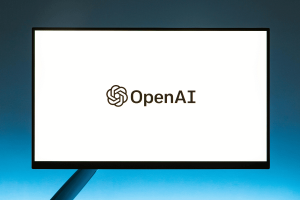For years, search engines have been our go-to for finding information. However, as time has passed, it has become more and more difficult to navigate the digital world. Enter ChatGPT online.
Imagine sitting in front of your computer, and instead of typing in search queries and wading through endless links, you simply ask a question—any question. Sounds too good to be true, right? With ChatGPT, that’s exactly how it works!
ChatGPT, developed by Open AI, made a grand entrance into the digital world in November 2022. Since its launch, it quickly became the center of attention. People from all over the world have experimented with the tool, from improving businesses’ customer service to creating marketing campaigns.
Read on and discover what ChatGPT online is, its advanced capabilities, features, and its promising future. While we’re at it, we’ll also answer a few frequently asked questions about this conversational AI tool.
What Is ChatGPT Online and How Does It Work
 Image by Sanket Mishra via Pexels
Image by Sanket Mishra via Pexels
Amid countless technological breakthroughs, there’s one name that stands out and grabs everyone’s attention: ChatGPT.
But what exactly is ChatGPT, and why has it captured the attention of so many?
In essence, ChatGPT online is a remarkable AI creation that acts as a chatbot, imitating human conversation with striking accuracy. Powered by natural language processing, it’s proficient at crafting responses to queries and generating various forms of written content, from articles to emails, with a remarkably human-like touch.
Operating within the confines of generative AI, ChatGPT allows users to input prompts and receive outputs comprising human-like text, images, or videos generated entirely by AI. It’s essentially an advanced version of the automated chat services commonly found on customer service websites. Users can interact with ChatGPT by asking questions or seeking clarification, much like they would with a human representative.
The “GPT” in ChatGPT stands for “Generative Pre-trained Transformer,” indicating its methodology in processing requests and formulating responses. Through a process of reinforcement learning, ChatGPT continuously improves its capabilities by leveraging human feedback and reward models to identify and rank the most effective responses.
Key Capabilities of ChatGPT Online
ChatGPT online is a shining example of innovation in conversational AI, pushing the limits of what was once believed to be achievable. Its advanced features enhance the quality of conversations and open doors to new levels of involvement and efficiency.
That said, here are the fundamental capabilities of ChatGPT:
Nuanced Dialogue Flow
The days of awkward and disconnected interactions are now a thing of the past, all thanks to ChatGPT online. ChatGPT excels in sustaining lengthy and logical discussions that cover a wide range of subjects and conversations. Plus, this AI chat tool allows users to have smooth and natural conversations where the context is effortlessly preserved, and follow-up questions receive thoughtful and appropriate answers.
Knowledge Synthesis
ChatGPT’s strength lies in its ability to combine vast amounts of information and knowledge with accuracy. By leveraging its extensive training on diverse datasets, ChatGPT can offer well-informed and nuanced responses to a wide variety of queries. Whether it’s simplifying complex concepts or providing expert insights, ChatGPT’s ability to synthesize knowledge empowers users with easy access to a wealth of information.
Creative Content Creation
ChatGPT displays generative writing skills, allowing it to create adaptable and interesting long-form content in various formats. Whether it’s fascinating stories, informative articles, poems, or emails, this AI chat online can generate content that caters to different needs and preferences.
Adaptability
ChatGPT can easily adapt and constantly enhance itself. By engaging in ongoing interactions and receiving feedback from users, this AI tool evolves and fine-tunes its responses, ensuring that it stays up-to-date and responsive to evolving needs and preferences. This adaptive learning process elevates the quality of conversations and empowers ChatGPT to stay ahead of the game.
Limitations of ChatGPT
Despite ChatGPT online’s impressive capabilities, it does have limitations. It’s important to acknowledge these restrictions and carefully consider ChatGPT’s responses, particularly in situations where accuracy and sensitivity are crucial.
Limited Context Understanding
While ChatGPT excels at understanding and generating human-like responses, its ability to comprehend context is not perfect. It may struggle to grasp complex or nuanced contexts, leading to occasional misunderstandings or irrelevant responses. ChatGPT users often have to rephrase their questions several times for the AI to understand their meaning.
Bias and Inaccuracy
ChatGPT online learns from vast datasets, which may contain biased or inaccurate information. As such, there’s a risk that ChatGPT’s responses may reflect biases or provide inaccurate information, especially on sensitive or controversial topics.
Lack of Emotional Intelligence
Although ChatGPT can simulate natural language conversations, it lacks emotional intelligence. This AI chat online tool cannot empathize with users or understand emotions, which may result in robotic responses, especially in emotionally charged interactions.
Innovative Features and Tools
In addition to its basic conversational skills, ChatGPT online offers extra features with the help of additional AI capabilities integrated by OpenAI.
Multimodal Interaction Support
ChatGPT now enables users to upload images, unlocking descriptive responses customized to the content of the image. This feature enhances the conversational experience by allowing users to interact with ChatGPT using various media formats. Additionally, integration with other OpenAI systems, such as DALL-E for image generation and Whisper for text-to-speech, expands ChatGPT’s capabilities. This, consequently, enables intelligent responses across different modalities.
API for Third-Party Integration
ChatGPT online offers a programming interface for developers to easily add its AI features to their apps. This expands ChatGPT’s availability across platforms and improves user engagement. For instance, Snapchat uses ChatGPT to power a chatbot for its users, showing how versatile ChatGPT is across different apps.
Content Moderation and Filtering
ChatGPT routes responses through AI moderation models to reduce the risk of toxic content, ensuring a safer and more positive user experience. However, the use of filters remains controversial due to concerns about potential bias.
Comprehensive Developer Documentation
Additionally, OpenAI provides comprehensive technical documentation that facilitates seamless integration of ChatGPT into existing workflows and environments. This enables developers to leverage ChatGPT’s capabilities effectively and efficiently.
How To Use ChatGPT
Curious about exploring ChatGPT but not sure where to begin? Look no further! Here’s your mini-guide to getting started with ChatGPT.
- Access ChatGPT online. Visit the ChatGPT website or open the ChatGPT application on your device.
- Figure out your purpose. It’s important to have a clear goal in mind before initiating a conversation with ChatGPT. You can ask ChatGPT a wide range of questions, from educational and informative to entertaining ones.
- Start a Conversation. Type your message or question into the chat interface using natural language. You don’t need to use specific keywords or commands. Simply ask your question or provide your input as you would when talking to a person.
- Refine or Continue. ChatGPT will process your input and generate a response based on its understanding of the conversation context and the information available to it. Depending on the response, you can refine your query or continue the conversation by asking follow-up questions or providing additional information.
- Utilize Media. If supported, you can also upload images or other media to enhance the conversation or request specific information related to the media content.
- Explore Features. Experiment with different features and functionalities of ChatGPT online, such as asking for creative writing prompts, generating code snippets, or seeking explanations on various topics.
- Review and Evaluate. Evaluate the accuracy and relevance of ChatGPT’s responses. Keep in mind that while ChatGPT strives to provide helpful answers, it may not always be perfect, so use critical thinking and judgment when interpreting its responses.
- End the Conversation. When you’re done with the conversation, simply exit the chat interface or close the ChatGPT application.
The Future of ChatGPT Online
Chatbots and language models have advanced far in recent years, and ChatGPT undoubtedly leads the way in this technological innovation. As these models continue to improve, it’s important to consider the future of ChatGPT and the possibilities it offers. Whether it’s customer service or language translation, the potential uses for this technology are limitless.
Enhancing Accessibility
ChatGPT online’s user-friendly interface and natural language processing capabilities are set to make technology more accessible to individuals across diverse demographics. From simplifying complex concepts to breaking down language barriers, ChatGPT democratizes access to information and empowers users worldwide.
Better Understanding of Human Language
ChatGPT continues to evolve and keeps getting smarter at understanding how humans converse. Put simply, ChatGPT and other language models cannot only decipher the meaning of words but also comprehend the context, tone, and intent behind them. Through continuous training and fine-tuning with extensive datasets, ChatGPT gets better at understanding the little details in human language. This means it can have more natural conversations with us, making it easier for us to communicate with it.
Increased Use in Customer Service and Support
More and more companies are turning to ChatGPT online and similar language models for their customer service and support needs. This means using the model to handle tasks like answering customer questions, troubleshooting problems, and giving information about products and services. In essence, the increased use of ChatGPT in customer service and support is a win-win for both companies and customers. Companies can provide better, more personalized service, and customers get faster, more accurate answers to their questions.
Application in Healthcare and Education
ChatGPT’s role extends to the healthcare and education sectors, where it offers valuable support and assistance. In healthcare, ChatGPT can serve as a virtual assistant, aiding doctors and nurses in patient care by answering queries, providing medical information, and even assisting with diagnoses. Similarly, in education, ChatGPT functions as a learning assistant, offering students guidance, answering questions, and aiding in homework assignments. Integrating ChatGPT online into medical and educational systems enhances accessibility to quality care and education, ultimately improving outcomes and efficiency in these critical fields.
Frequently Asked Questions
Is ChatGPT capable of generating text in multiple languages?
Yes, ChatGPT can generate text in various languages. This versatility makes it an adaptable tool suitable for diverse projects and applications.
Can ChatGPT access live internet browsing or private user data?
No, ChatGPT does not have access to browse the live internet or private user data. It operates within predefined parameters and cannot access external websites or personal data.
Is ChatGPT safe to use in my projects?
ChatGPT is designed with security measures in place to ensure the safety of user interactions. Plus, OpenAI, the developer of ChatGPT, continuously monitors and updates the model to address any potential security vulnerabilities. Still, it’s important to adhere to industry standards and best practices for data security and privacy when using ChatGPT, as with any AI tool.
What happens to conversations users have with ChatGPT?
Conversations users have with ChatGPT are typically processed temporarily for generating responses and improving the model’s performance. They are not stored or used to identify individuals to guarantee user privacy and confidentiality.
Is it possible for ChatGPT to decline answering prompts?
Yes, ChatGPT may occasionally choose not to respond to certain prompts. AI systems like ChatGPT can reject inappropriate requests to prevent the generation of unsafe content, which may include questions that violate rights, are offensive, discriminatory, or involve illegal activities. Additionally, the model can challenge incorrect premises, answer follow-up questions, and acknowledge mistakes when pointed out by users.
ChatGPT Online: Bridging the Gap Between Humans and Machines
In a nutshell, ChatGPT online is an innovative tool in the field of artificial intelligence. It gives us a glimpse into a future were interacting with computers is easier and more natural. With its advanced capabilities, ChatGPT shows us how AI can change the way we communicate and access information. However, it’s important to recognize its limitations, such as not fully understanding context, and the potential for bias.
As ChatGPT continues to improve and add new features, it can be used in various areas like customer service, healthcare, and education, making things more accessible and efficient. By advancing responsibly and considering ethical implications, ChatGPT is leading us toward a future where we are more connected and well-informed.






